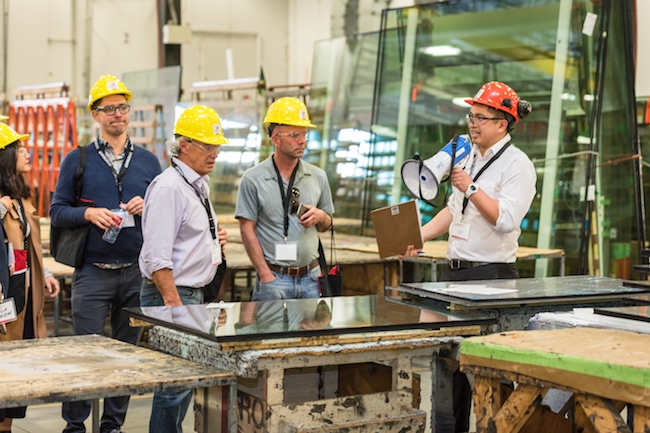
Features
Community
Event reports
Garibaldi Glass hosts successful Glass Day 2018
May 17, 2018 By Garibaldi Glass

May 17, 2018 – It’s safe to say that Glass Day, presented by Burnaby B.C.’s Garibaldi Glass, is the most successful and informative educational fenestration event in western Canada and beyond. It’s a bold statement. The Mobius brothers (introductions not required, everyone knows them) and their team welcomed over 400 glazing contractors, architects, designers and glass professionals from across Canada, the US and even Europe to this year’s event. Attendees were treated to a fabulous Cinco De Mayo lunch complete with icy cold Coronas in between plant tours, networking and a variety of rotating AIA/AIBC accredited seminars that were being held in Garibaldi’s top notch conference rooms, training room and full size theatre.
“This is our 8th annual Glass Day however it’s not just about glass,” said Carey Mobius, CEO of Garibaldi. “It’s about the entire building envelope. The jewelry on the buildings. The eyebrows. The size of the podium products. Stone being incorporated. The purpose of what we do for Glass Day is really to help educate people on what’s going on out in the marketplace. Every year we bring speakers in and this year we had some absolutely phenomenal, world-class speakers with us. There was a lot of education with a fantastic turnout of people.”
This year’s event wasn’t only exceptional for Garibaldi because the attendance was the highest it has ever been. This year, Carey, Chris and Craig got to show off their new toy, a brand new 130” x 256” oversize tempering furnace from renowned Finish glass machinery manufacturer, Taifin.
“Today’s attendance has been fabulous,” said Andrea Barlow, Senior Buyer for Garibaldi. “It’s the highest attendance and most diverse crowd of customers, vendors and architects that we’ve ever had. They want to see the new tempering line. Architects want to go bigger and we’re all set up and ready for as soon as the jumbo coaters from the primaries come online with larger stock sheets of low-e.”
Understandably, several seminars included various components of oversize. “The seminar on handling big glass by Bryan Strobel and Daniel Meuchel of Wood’s Powr-Grip has been very popular,” shared Barlow. The enlightening presentation shared case studies and solutions on some of the many challenges in planning and executing a heavy lift. “Sizes are getting bigger and bigger all the time so you need new equipment to handle it and people need to be trained,” said Barlow.
Glass rookies (there were a lot), got the basics from Russ Rozanskas’ “Glass 101” presentation. “Glass 101 is for people that don’t have a lot of glass knowledge or want to brush up on their knowledge,” said Barlow. The veterans literally lined up for “Designing with Structural Glass Interlayers” presented by Mark Jacobson of Kuraray America and “When to Use Storefront of Curtainwall Construction” hosted by Chris Lambart of Kawneer Co.
The keynote seminar with something for everyone was the Design Challenges & Trends panel discussion. Moderated by Carey Mobius, the panel included James Cheng, principal of James KM Cheng Architects Inc., Doug Walker, technical director for Permasteelisa, Larry Carbary, industry scientist for Dow Corning USA and Steve Thomas, regional technical advisor for Guardian Glass. Talk about heavy hitters. And the packed room was eager to hear what they had to say.
“Glass is probably the most complicated topic one could have as a designer,” said Cheng. “We look at all the methods of construction. Glass is the one that changes the most in terms of technology. We started out with small panes of flat glass. We went from single pane to double glaze to triple glaze. Now we can curve and bend them. If we look at other construction materials like stone or brick, there is an inherit limit on what that material can do. But glass is totally changing. It is always responding to the energy requirements. We are learning that with triple glaze that we can actually improve the performance of Passive House and put more window area into that kind of system. And with the technology that is being developed, we could have 2-hour fire-rated glass that could open up underground parking lobbies with glass. We have structural glass that Apple and others that have pioneered that can do all kinds of things. There is almost no limit. As designers, we’re constantly struggling to see what can do.”
“The question now becomes has it been tested,” added Mobius. “They are designing before we even have a recognized lifespan for some of these products. Those run fear through my blood.”
“Those are our fears as architects as well,” agreed Cheng. “A lot of design firms share experience and expertise. We do talk to each other. We pick up the phone and say ‘Hey, you did this project. What was your experience? Are you happy with it?’”
“Permasteelisa functions more as a design engineering firm than a construction firm,” said Walker. “The earlier we can get a team together to contribute knowledge and look at any product constraints, the better. The Devil is in the details. If you don’t know, build a mockup as soon as possible.”
“The sooner that we can get together to look at everything that is implied by the design in terms of structural performance, thermal stresses, acoustic performance if applicable and the over overall design considerations, the better things will turnout,” agreed Thomas. “Especially to scrutinize design relative to what’s been done in the past.”
“If you think that there are things that are not adequate in the standards and you see a need to change them, you have to participate in the standards process,” shared Carbary. “Because if you are not in charge of writing the standards, you are going to be following them.”
Print this page
Leave a Reply